To ensure your home is safe and secure, start by scheduling an asbestos inspection, especially if it was built before 1985. A certified inspector will evaluate materials for asbestos exposure risks, which can lead to serious health issues. Pay attention to common indicators like damaged ceiling tiles or old vinyl flooring. If asbestos is found, follow safety guidelines for handling and adequately dispose of materials at authorized sites. Keeping abreast of legal obligations and performing regular checks will help maintain safety. There's much more to learn about managing asbestos hazards effectively to protect your home and family.
Importance of Asbestos Inspections
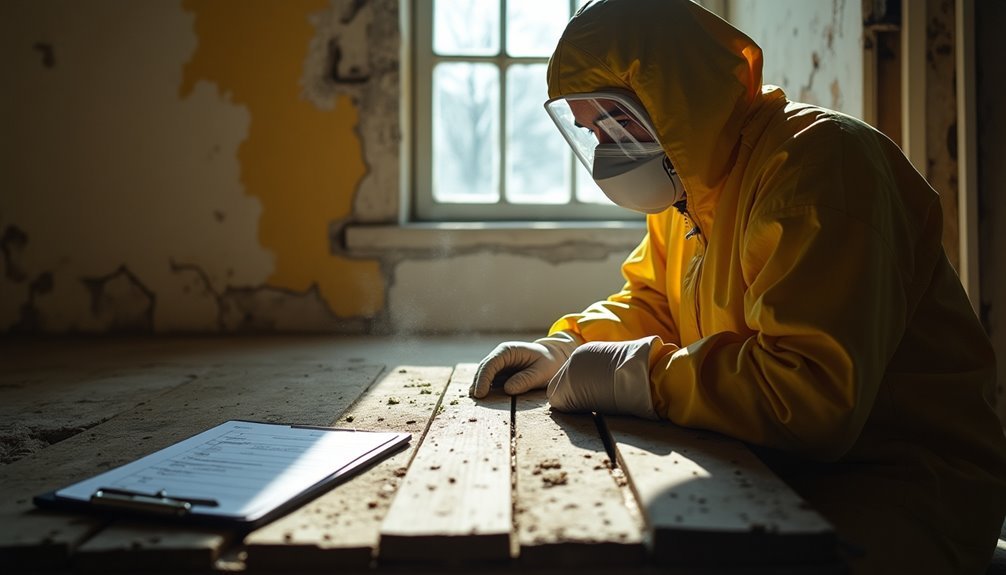
The importance of asbestos inspections cannot be overstated, as they play a crucial role in safeguarding public health and ensuring regulatory compliance. Many people cling to asbestos myths, believing that as long as they don't see it, they're safe. However, the reality is that disturbing asbestos-containing materials can release harmful fibers into the air, leading to severe health implications, including lung cancer and mesothelioma.
Regular inspections are vital to identify and address these materials before they pose a risk. By ensuring that professional, EPA-certified inspectors conduct thorough assessments, you not only comply with federal and state regulations but also protect your home and community. Inspections help you avoid costly remediation down the line by catching potential issues early. Certified inspectors assess and quantify asbestos presence on properties, which is essential for safety.
Moreover, having documented inspection reports can enhance your property's value and appeal to potential buyers who prioritize safety. Remember, knowledge is power; understanding the reality of asbestos and its risks empowers you to take proactive steps. Don't let misconceptions dictate your safety. Regular inspections are your best defense against the hidden dangers of asbestos exposure.
When to Schedule an Inspection
Scheduling an asbestos inspection is essential for maintaining safety in environments where asbestos-containing materials may be present. You should schedule an inspection if you notice any damaged or deteriorating materials, such as cracks or water damage in ceilings, walls, or flooring. Pay particular attention to popcorn ceilings and vinyl tiles, as these are common areas where asbestos may be found. If you see any signs of wear, don't hesitate to take immediate action and arrange for an inspection to prevent potential fiber release.
Additionally, if you're planning any renovation or demolition work, it's crucial to schedule an inspection beforehand. Federal regulations require this to ensure safety for both workers and occupants, while also helping to identify hidden materials that may pose risks. Asbestos is highly carcinogenic when inhaled, making it vital to address any concerns proactively.
Buildings constructed before 2000 typically require more frequent inspections due to their likelihood of containing asbestos. High-occupancy areas, like schools and hospitals, should also undergo regular checks. Lastly, if your building has faced natural disasters or structural changes, you'll want to reassess the situation and stay updated on any new legal requirements. By prioritizing inspection frequency and enhancing your asbestos awareness, you can help safeguard your environment.
Understanding the Inspection Process
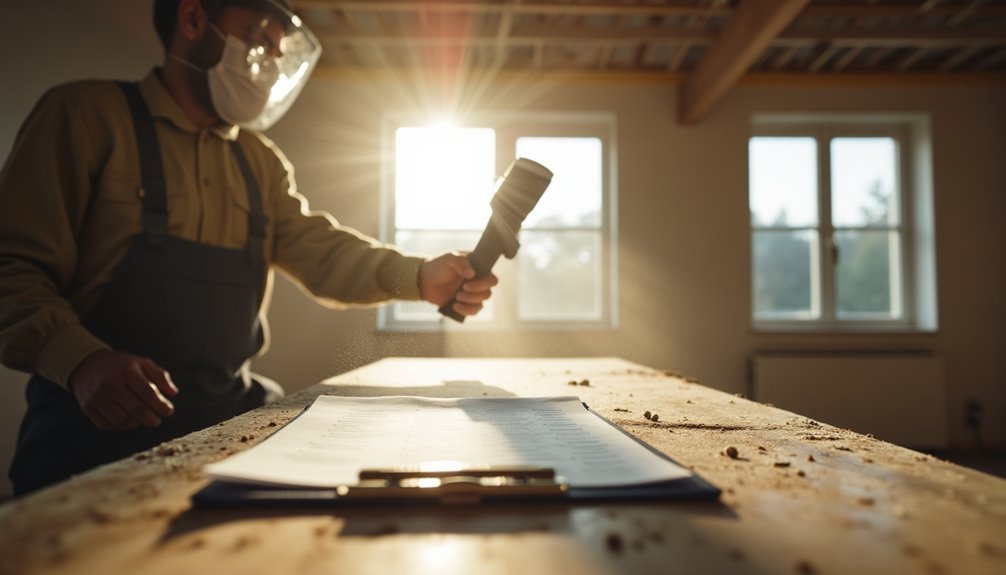
When you're preparing for an asbestos inspection, it's crucial to understand the role of a certified inspector. They'll guide you through the sampling and analysis process, ensuring that every step is conducted safely and effectively. Knowing what to expect can help you feel more informed and in control throughout the entire inspection.
Certified Inspector Requirements
Navigating the complexities of certified inspector requirements is crucial for anyone involved in asbestos inspections. Understanding the inspector qualifications is your first step. You need an "Inspector Certificate" from the New York State Department of Labor (NYSDOL), which requires two years of documented experience in building surveys or hazard assessments for asbestos-containing materials (ACM).
Here's a quick overview of the certification process:
| Requirement | Details |
|---|---|
| Experience | 2 years in ACM assessment & 3 years in related building surveys or equivalent education |
| Training | 2-5 days at accredited agencies covering asbestos roles, characteristics, exposure, and sampling |
| Certification Validity | NYSDOL certificate: 1 year; DEP certificate: 2-3 years based on your birthday |
Additionally, you must pass an exam with a score of at least 70% and complete annual refresher training. Compliance with the Asbestos Hazard Emergency Response Act (AHERA) norms is non-negotiable. Remember, you're responsible for conducting thorough inspections, maintaining accurate records, and ensuring the safety of everyone involved. Your diligence in meeting these requirements helps ensure a safe environment for all.
Sampling and Analysis Process
Understanding the sampling and analysis process is vital for conducting thorough asbestos inspections, as it ensures accurate identification of hazardous materials. Start by pinpointing areas with suspect materials, like thermal system insulation or roof coverings. Before you begin sample collection, make sure the area is well-ventilated and unoccupied. Lay down disposable plastic sheeting to catch any dust, securing it with tape. Use a mixture of PVA glue and water to minimize fiber release while sampling. When obtaining a sample, ensure you capture the full depth of the material using a small chisel or pliers.
Safety is paramount; always wear Personal Protective Equipment (PPE) and Respiratory Protective Equipment (RPE). Dampen the area to reduce fiber release, and double bag samples in Ziploc bags to prevent contamination. Once samples are collected, they're sent to an accredited laboratory for analysis. Methods like Polarized Light Microscopy (PLM) or Transmission Electron Microscopy (TEM) identify the asbestos type and percentage composition. The laboratory analysis results guide your next steps, ensuring the safety and security of your home from hazardous materials.
Safety Measures for Inspectors
Asbestos inspections require strict safety measures to protect both inspectors and the surrounding environment. First, secure the area by isolating it from the rest of the property to prevent asbestos fibers from spreading. Cut off all ventilation, seal vents, and use plastic sheeting to contain fibers. Establish barriers to minimize air disturbance and mitigate health risks.
As an inspector, you must adhere to comprehensive safety protocols. Wear disposable protective clothing like coveralls, head covers, and foot covers made of synthetic fabric, ensuring they fit tightly at the openings. Use appropriate respiratory protection, such as negative-pressure respirators or powered air-purifying respirators. Single-use gloves and safety goggles are essential to avoid contamination and protect your eyes.
When taking samples, utilize specialized equipment designed to minimize disturbance. Follow strict protocols to avoid damaging asbestos-containing materials, and always store samples in sealed containers during transport. After inspections, clean up thoroughly by using HEPA filter vacuums and washing exposed skin with soap and water. Remember, proper inspector training is critical to ensure these safety measures are effectively implemented, safeguarding both you and the environment from asbestos exposure.
Identifying Potential Asbestos Materials
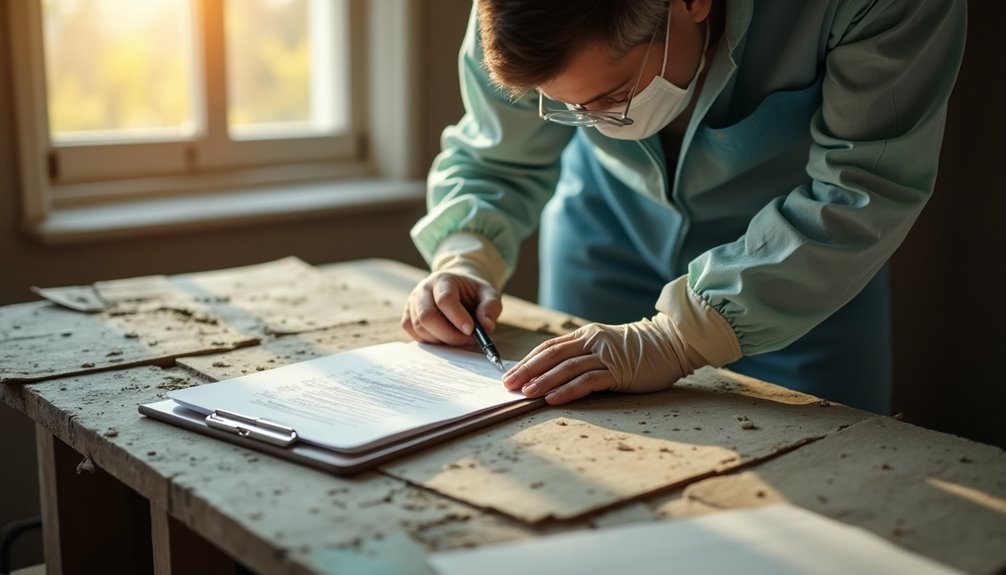
After implementing the necessary safety measures, you'll need to focus on identifying potential asbestos materials within the property. Start by examining common areas where asbestos might be present. Look for asbestos signs such as fibrous materials or wavy patterns in siding. Homes built before 1980, particularly those from the mid-20th century, are more likely to contain asbestos.
| Material | Potential Asbestos Signs | Notes |
|---|---|---|
| Floor Tiles | Vinyl tiles, especially 9×9 inches | Common in older homes |
| Ceiling Tiles | Textured or popcorn ceilings | Often found in living spaces |
| Insulation | Vermiculite insulation, especially in attics | Check both walls and ceilings |
Pay attention to the age and renovation background of your home. If it hasn't been significantly renovated, the risk increases. Look for wear and damage, such as tears or water stains, which can indicate asbestos presence. Identifying materials early can protect your health and ensure a safer living environment.
DIY Testing vs. Professional Testing
When considering whether to conduct DIY testing or hire a professional, it's crucial to weigh the benefits and risks associated with each option. DIY testing can be appealing due to its affordability, often costing between $50 to $100 AUD. You can find test kits in hardware stores and online, allowing you to collect samples and send them to a lab for analysis. However, the risks are significant. Disturbing asbestos materials can release harmful fibers, posing health risks to you and others. Moreover, ensuring sample accuracy can be challenging, and some states may even restrict DIY testing.
On the other hand, professional testing offers accuracy and reliability. Trained inspectors conduct thorough assessments that include both solid and airborne asbestos detection. They follow strict safety protocols, minimizing exposure risks. The peace of mind that comes from knowing a professional has conducted the inspection is invaluable. Additionally, the reports generated can be critical for legal matters or real estate transactions. Ultimately, while DIY testing may seem cost-effective, professional testing ensures safety and accuracy, making it the wiser choice for safeguarding your home and loved ones.
Safe Handling of Asbestos
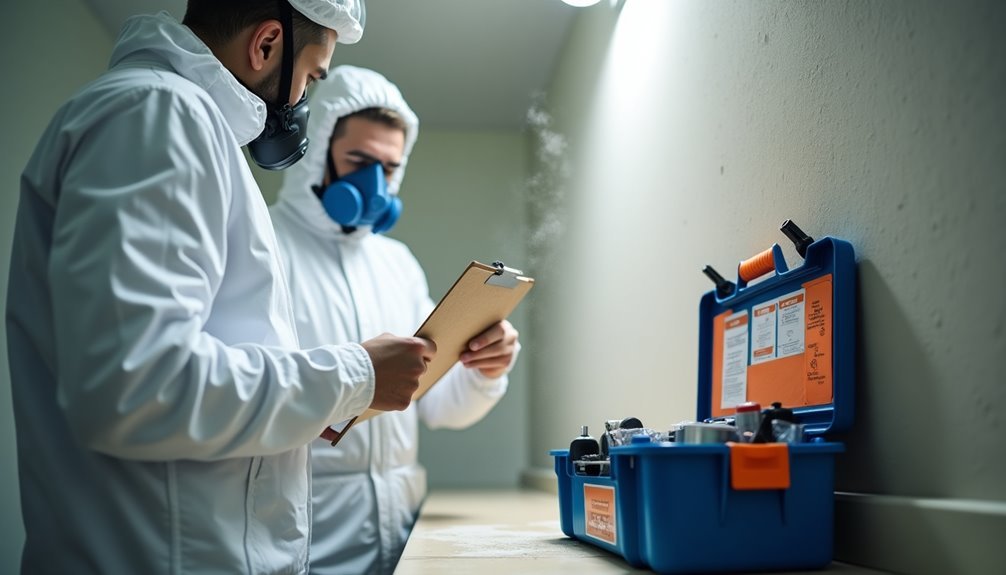
Handling asbestos safely requires careful preparation and adherence to strict protocols. Before starting any asbestos removal project, inform your neighbors about the work and advise them to close their doors and windows. Seal all windows and doors in your home and cover air vents to prevent asbestos fibers from infiltrating. Remove play equipment, personal belongings, and vehicles from the work area, and ensure that household members, visitors, and pets stay away until the cleanup is complete.
Wear appropriate personal protective equipment, including respirators, disposable gloves, and coveralls. Use non-powered hand tools to minimize dust generation and ensure that all protective gear is disposed of properly after the job. Shower and wash your hair immediately afterward to eliminate any fibers that may have clung to you.
When working, wet the asbestos materials regularly to control dust. Avoid using power tools or high-pressure water jets, as these can increase health risks. Clean the work area thoroughly with wet rags or a HEPA-filtered vacuum. Remember to double bag and seal any materials used during cleanup for safe disposal to mitigate the dangers associated with asbestos exposure.
Disposal Guidelines for Asbestos
Proper disposal of asbestos is crucial to ensure safety and compliance with regulations. You must first identify any asbestos-containing materials (ACMs) in your home, distinguishing between friable and non-friable types. For compliance with asbestos regulations, always notify the appropriate state agency before any demolition or renovation that involves ACMs.
When it comes to disposal methods, consider these guidelines:
- Seal and label: ACMs should be sealed in leak-tight containers while wet and clearly labeled to prevent hazardous dust exposure.
- Use approved facilities: Ensure that you dispose of ACMs at landfills that are specifically approved to accept hazardous waste.
- Complete necessary paperwork: An Asbestos Disposal Form must be submitted for approval to the relevant authorities before disposal.
What to Do Post-Inspection
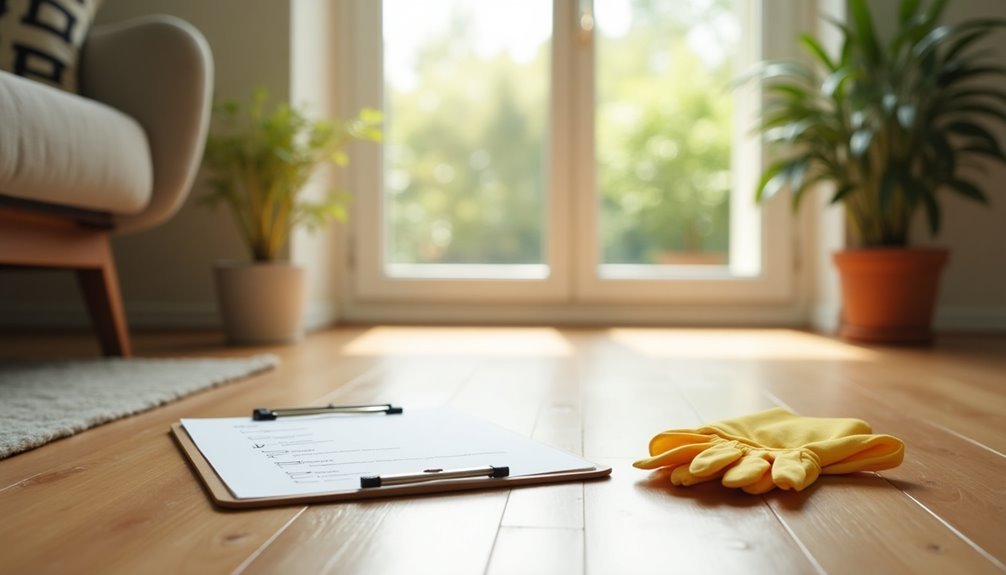
After your inspection, the first step is to leave any asbestos-containing materials undisturbed to minimize risk. If you notice any damage, repair it promptly to prevent fiber release, and ensure those repairs are handled by trained professionals. Additionally, inform your neighbors about the presence of asbestos, as they have a right to know about potential hazards that may affect them.
Leave Materials Undisturbed
While it's tempting to tackle any visible issues with asbestos-containing materials (ACMs) post-inspection, the safest approach is to leave them undisturbed if they're in good condition. Asbestos awareness is crucial here; materials that aren't damaged or disturbed won't release harmful fibers. By avoiding unnecessary disturbance, you prevent creating a health hazard where none existed before.
To ensure safety, consider the following guidelines:
- Educate household members about the locations of ACMs to prevent unintentional disturbance.
- Avoid DIY projects or renovations in areas with ACMs, as these actions can release dangerous fibers.
- Regularly monitor known ACMs through annual inspections to maintain their integrity.
When you leave materials undisturbed, you not only protect your health but also embrace disturbance prevention. If you suspect any issues or damage, always consult certified professionals for further evaluation and guidance. Remember, managing asbestos in place is often the best strategy, so keep your home safe and secure by respecting the condition of these materials.
Repair Damage Promptly
Leaving asbestos-containing materials undisturbed is a wise choice, but what happens when you discover damage during an inspection? A thorough damage assessment is crucial. Start by visually inspecting the area for signs like tears or water damage, and consider laboratory analysis for suspected materials. You need to determine the extent of the damage to select appropriate repair methods.
Here's a quick overview of your options:
| Repair Method | Description |
|---|---|
| Sealing (Encapsulation) | Treats material with sealant to prevent fiber release. |
| Covering (Enclosure) | Wraps the material to isolate it from the environment. |
| Minor Repairs | Small fixes like filling holes, done by professionals. |
Once you've assessed the damage, prepare the work area by isolating it and using protective coverings. Execute repairs strictly through trained professionals, especially for major work. After repairs, conduct a thorough cleaning to ensure safety. Prompt repair not only protects your health but also preserves your home's integrity. Don't delay; addressing asbestos damage swiftly can liberate you from potential dangers.
Inform Neighbors Properly
When you discover asbestos during an inspection, it's essential to inform your neighbors about its presence, especially if any materials are disturbed. This proactive approach fosters asbestos awareness within your community and ensures everyone's safety. Consider implementing effective communication strategies to relay this critical information clearly.
- Notify neighbors promptly about the situation and any immediate risks.
- Share safety measures you're taking to mitigate asbestos exposure during renovations.
- Provide resources for further education on asbestos safety and local regulations.
Make sure to follow local guidelines regarding notifications, as state or local regulations may impose specific disclosure requirements. If your neighbors express concern, encourage them to inquire whether the materials have been tested for asbestos. By assuring them that you're employing trained professionals and taking necessary precautions, you can alleviate fears.
Legal Responsibilities for Homeowners
Understanding your legal responsibilities regarding asbestos inspections is crucial, especially if you're planning any renovation or demolition work on your property. As a homeowner, it's your obligation to ensure that an accredited inspector assesses your building for asbestos-containing materials (ACM) before you start any project, especially if your home was built before 1985. If ACM is found, you must ensure it's properly abated before proceeding, as failing to do so can lead to serious legal consequences.
While single-family homes or those with four or fewer units are generally exempt from these requirements, exceptions apply if your project involves commercial development. Always keep in mind that even small amounts of regulated ACM may necessitate an inspection.
After the inspection, if ACM is discovered, you must provide certification to local authorities confirming that the materials will be handled by licensed contractors. Not adhering to these homeowner obligations can result in significant fines and even halt your renovation plans. Therefore, staying informed about your legal responsibilities is essential for both your safety and compliance with the law.
Conclusion
In summary, safeguarding your space starts with serious asbestos inspections. By scheduling assessments, spotting suspicious substances, and ensuring safe handling, you protect your home and health. Remember, proper disposal and post-inspection protocols are paramount. Don't neglect your legal responsibilities; being proactive prevents perilous problems. Stay vigilant, informed, and involved to create a secure sanctuary for yourself and your loved ones. Prioritize prevention, and you'll promote peace of mind in your living environment.
